There are various types of green peppers that are available in today’s market – some have mild spiciness, while others are torture to the human taste buds. Some can be eaten raw, dried, or turned into powder, while others need to be cooked first to maximize their flavor.
For this article, we will talk about 19 types of green peppers, their uses, and their heat level. We will be using the Scoville Heat Unit to rate the spiciness of a pepper with zero being the lowest up to 16 million being pure capsaicin.
Table of Contents
1. Anaheim Pepper

Scoville Heat Units: 500-2,500
The Anaheim pepper is a long, medium-sized green pepper that was made popular in Anaheim, California, hence its name. Once it matures, this pepper turns from green to deep red, and then it is called California red chile.
One of the most common chili peppers found in the United States, the Anaheim pepper has a mild flavor and heat and is most commonly used in salsas and food recipes.
In addition, they can be roasted, canned, and they can also be stuffed with cheese – just like how people would do with bell peppers, although a very mild heat is to be expected when using this pepper.
In the market, Anaheim peppers are commonly sold fresh or canned.
2. Ancho Ranchero Pepper
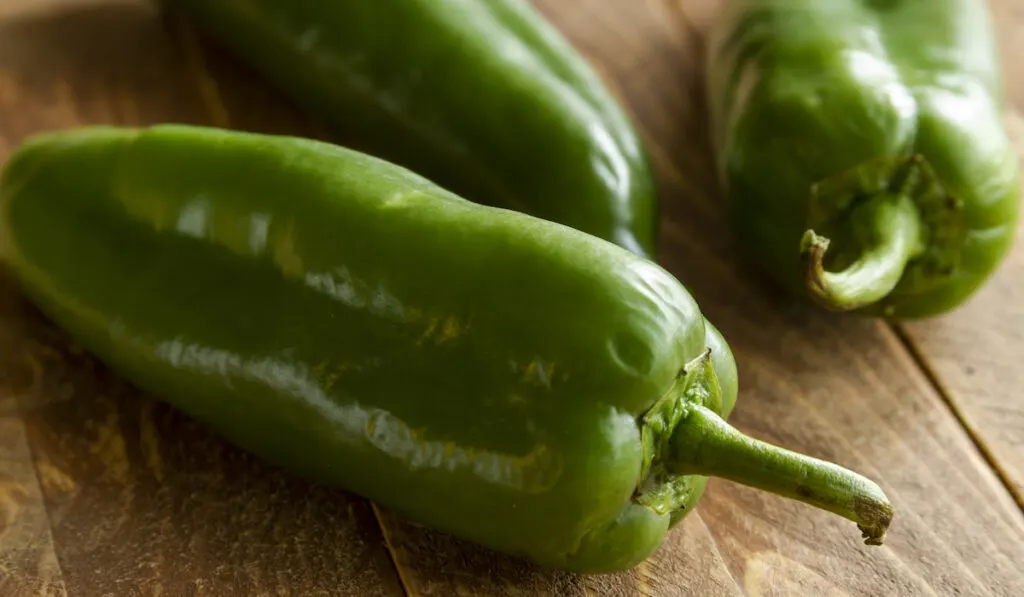
Scoville Heat Units: 1,000 to 2,000
The Ancho Ranchero pepper is the mild but larger hybrid of Poblano chili pepper which will be tackled later in this post. It has medium-thick flesh and is best used for roasting, stuffing, or making Mexican cuisine.
The Ancho Ranchero pepper is green in color but it turns deep red once fully matured. Nevertheless, both colors are suitable for adding to various dishes.
3. Barker’s Hot Chili Pepper
Scoville Heat Units: 15,000 to 30,000
The Barker’s Hot chili pepper is the hottest pepper of the Anaheim variety. Although it is extra hot, this green pepper comes with an excellent flavor. With their thin skin, Barker’s Hot chili pepper is an excellent choice for roasting, canning, frying, and stuffing. They can also be used to make hot salsa.
This variety thrives in a very hot, dry climate, and can grow up to about 5 to 7 inches long. Maturing from green to red, the red variety is hotter than the green one.
4. Bell Pepper
Scoville Heat Units: 0
Bell peppers do not contain capsaicin, and therefore they have zero SHU. Also called capsicum, this pepper variety also comes in yellow, white, orange, pink, purple, and red. With their wide variety of colors, along with their high-water content, bell peppers are great for adding moisture and color to dishes.
Because of their sweet taste, bell peppers can be eaten raw with dip, or they can also be cooked and added to build flavor in different cuisines.
Moreover, they can also be dried and turned into a powder and referred to as paprika.
5. Bird’s Eye Chili Pepper
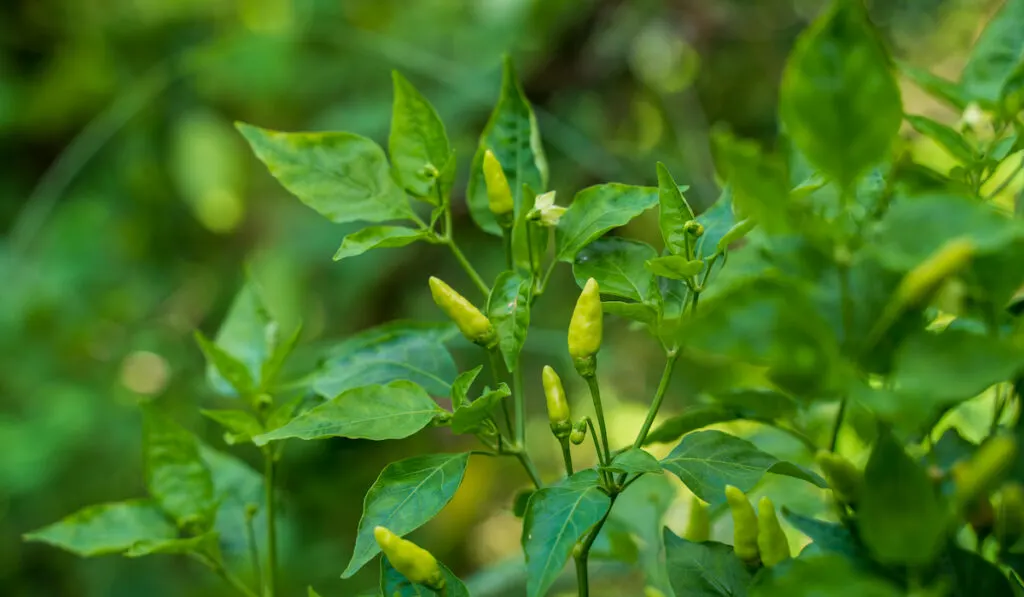
Scoville Heat Units: 50,000 to 100,000
A type of Thai pepper, the Bird’s Eye chili pepper falls somewhere between Habanero pepper and Cayenne pepper. This tiny pepper variety originated in Cambodia, Thailand, Vietnam, and the Philippines where they are commonly used to bring heat to different dishes.
The Bird’s Eye chili pepper turns red once fully ripe, and both colors are often used to add heat to soups, salads, pasta, stir-fries, sauces, dips, sambals, and marinade. They can also be dried and turned into chili powder.
Today, the Bird’s Eye chili pepper can be found all over the world.
6. Charleston Hot Chili Pepper
Scoville Heat Units: 70,000 to 100,000
Developed by the U.S. Department of Agriculture in South Carolina, the Charleston Hot chili pepper is a variety of cayenne pepper, though it is much hotter than a regular cayenne. Despite being almost as hot as Habanero peppers, the Charleston Hot comes with an excellent cayenne flavor.
Unripe Charleston Hots are green in color, and they turn to yellow, orange, and bright red when they reach their full maturity. While they are harvested during maturity, they can also be picked while still green.
Charleston Hot is commonly used just like how people would use a cayenne. The only difference is that this pepper brings some extra heat.
7. Chilaca Pepper
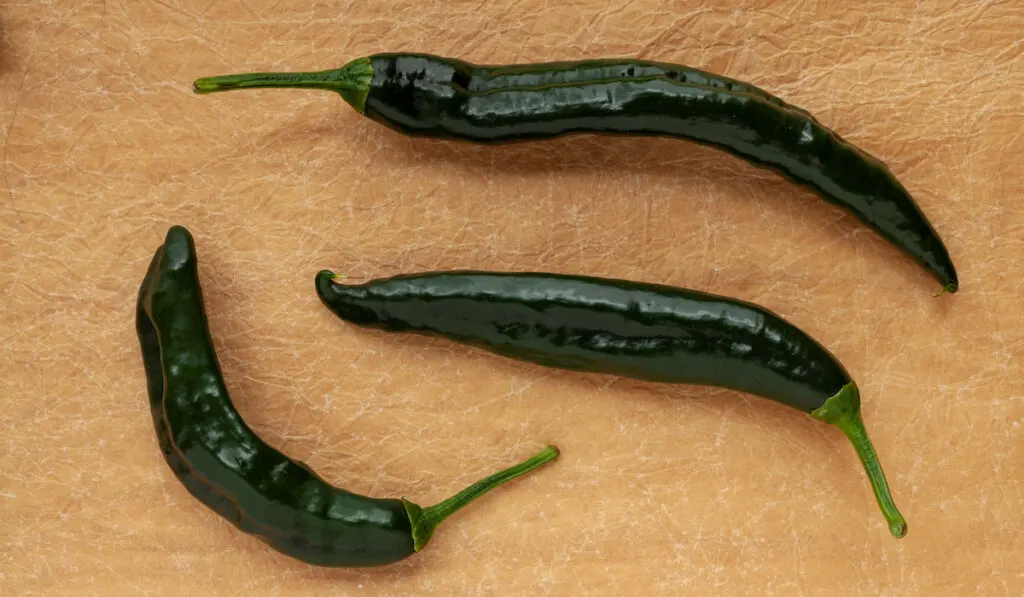
Scoville Heat Units: 1,000-2,500
An essential part of Mexican cuisine, the Chilaca pepper is a dark green pepper with a mildly hot flavor. The chili pods are 6 to 9 inches long and 1 inch wide. The skin is wrinkled, and the peppers are flat in shape. When dried, they turn from dark green to brown-black where they are called Chile Negro or Pasilla Pepper.
Fresh chilaca peppers can be used to make salsa, and they can also be grilled and roasted. However, because of their thin skin, chilaca peppers are not the best choice for stuffing, they can still be stuffed.
On the other hand, the dried form of this pepper is more popularly used than the fresh ones. The Pasilla pepper is commonly used to make sauces, and they can also be powdered and made into condiments.
8. Cubanelle Pepper
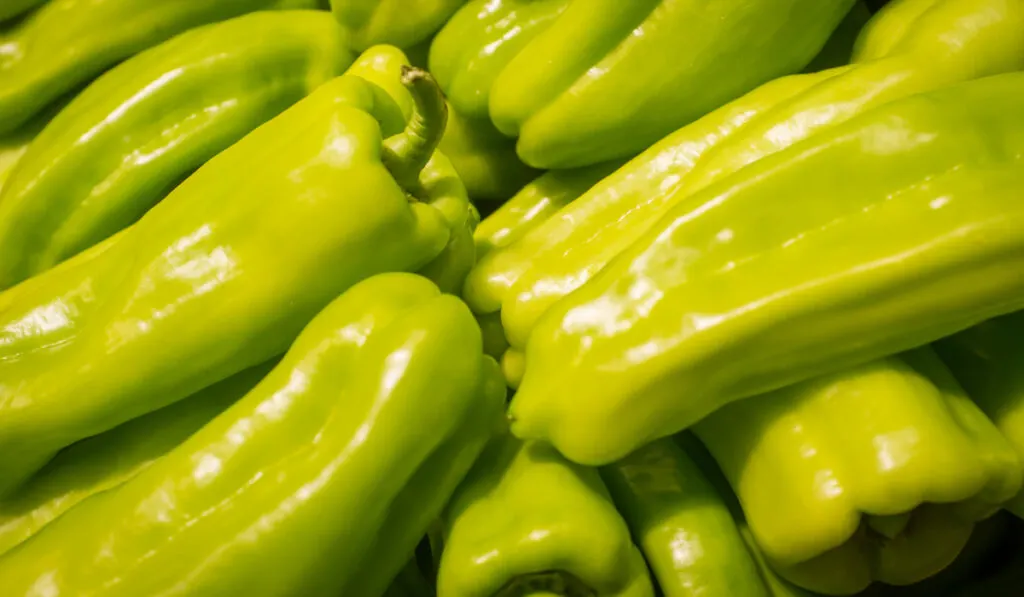
Scoville Heat Units: 0 to 1,000
Also called Cuban pepper or Italian Frying Pepper, this type of pepper can be used as a substitute for bell peppers due to its sweet flavor and mild heat. It is usually used in Central America, such as Cuba, Dominican Republic, and Puerto Rico, though they are also readily available in the United States.
Cubanelle peppers have shiny skin, firm flesh, and they are commonly picked while still light green or yellow-green in color. Once they are fully mature, they turn from red to orange-red.
Cubanelles are a great choice for cooking in a frying pan with a little bit of olive oil. They can also be added to salads, casseroles, sauces, and pizzas. Because of their size, Cubanelles can also be used for stuffing.
9. Guindilla Pepper
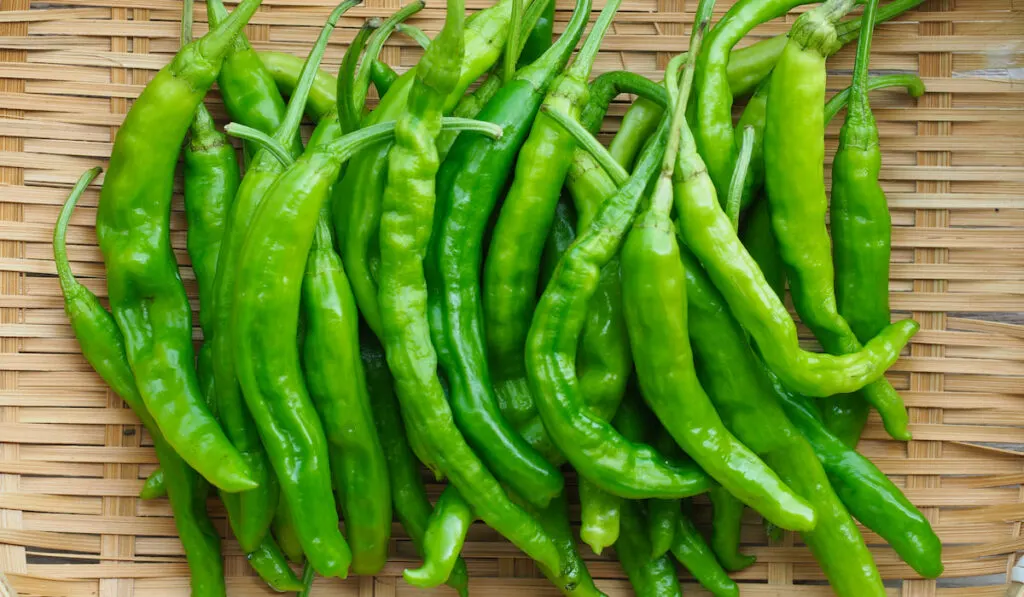
Scoville Heat Units: 1,000 to 2,000
Cultivated and processed in the Basque Country in Spain, the Guindilla chili pepper has a mild flavor of sweetness and spiciness.
They are usually pickled in white wine vinegar, but they can also be used as a garnish in cocktails, such as in Bloody Mary drinks. In addition, they can also be prepared alongside cheese where they are paired with white wine.
10. Hatch Peppers

Scoville Heat Units: 1,000 to 8,000 or hotter
Hatch peppers are grown in the Hatch Valley region of New Mexico, hence their name. They are long, shiny green peppers with thick flesh.
Known for their quality and flavor, Hatch peppers are quite pungent like onions, with a little bit of spiciness and smoky flavor. Hatch peppers can be eaten fresh, but they are commonly roasted.
11. Hidalgo Chili Peppers
Scoville Heat Units: 6,000 to 17,000
An heirloom pepper, the Hidalgo chili pepper originated from Mexico and Central America. It grows up to about 2” long and has thick, glossy skin that turns from dark green to red when it matures.
The Hidalgo chili pepper is an excellent choice for pickling, though it can be used in salsa and in sauces, too.
12. Jalapeño Pepper
Scoville Heat Units: 3,500 to 8,000
The Jalapeño pepper from Mexico is a type of pepper that is harvested while it is still green because once they turn red, it will have a bit of a fruity flavor.
As one of the most common types of peppers that are used in different dishes, Jalapeño peppers are usually used to make sauces, salsa, chilis, soups, and salads.
When smoked and dried, the Jalapeño pepper is called chipotle.
Chipotle can be mellow or spicier, and with its smoky and a hint of spicy flavor, chipotle makes a great addition to salsa and sauces as well.
13. Padrón Peppers

Scoville Heat Units: 500 to 2,500
Also called pimiento de padrón, Padrón peppers are cultivated in northwestern Spain. It is a small, green pepper that grows to about 3 inches long. Once fully matured, this green pepper turns a vibrant red.
Generally sweet and mild in flavor, some Padrón peppers will surprise you with their heat. A Padrón pepper’s spiciness will have to do with their growing conditions, and the only way to know their level of spiciness is by giving them a taste.
This pepper is usually served as tapas, with a quick frying and tossing with salt. They can be grilled as well.
14. Poblano Pepper

Scoville Heat Units: 1,000 to 2,000
Originating from Puebla, Mexico, Poblano peppers are large, heart-shaped peppers with a mild heat. Popularly used in Mexican dishes, Poblano peppers start out dark green and they turn into dark red-brown as they mature. This type of pepper is usually harvested while still green.
Poblano peppers are usually roasted, stuffed, or added into sauces. They’re also commonly used in making chile Relleno. When dried, Poblano pepper is called Ancho chilis where it gives off a sweetness similar to raisins.
15. Sandia Chili Peppers
Scoville Heat Units: 5,000-7,000 SHU
Sandia Chili peppers are hybrid peppers from New Mexico. They grow to about 6 to 7 inches in length, similar to the Anaheim pepper. Like the Poblano pepper, the Sandia chili pepper is picked while still green. Once fully matured, they turn red and can be dried.
This pepper can be roasted, or chopped and added to salsa. They can also be used to make chiles Rellenos. Sandia chili pepper does give a little bit of kick to dishes, but is still tolerable and not too overwhelming.
16. Serrano Pepper
Scoville Heat Units: 10,000 to 23,000
Serrano peppers are small at about 1 to 4 inches long and ½ inches wide, but they are packed with heat. They are hotter than Jalapenos, but not too hot like Habaneros. Usually green in color, Serrano peppers can also come in other colors, including yellow, orange, red, and brown.
Popularly used in Mexican and Thai cuisines, Serrano peppers can be chopped and added into salsa, sauces, relishes, and guacamole.
They can also be roasted or pan-cooked. Because they are meaty peppers, they don’t make an excellent choice for drying.
17. Shishito Pepper
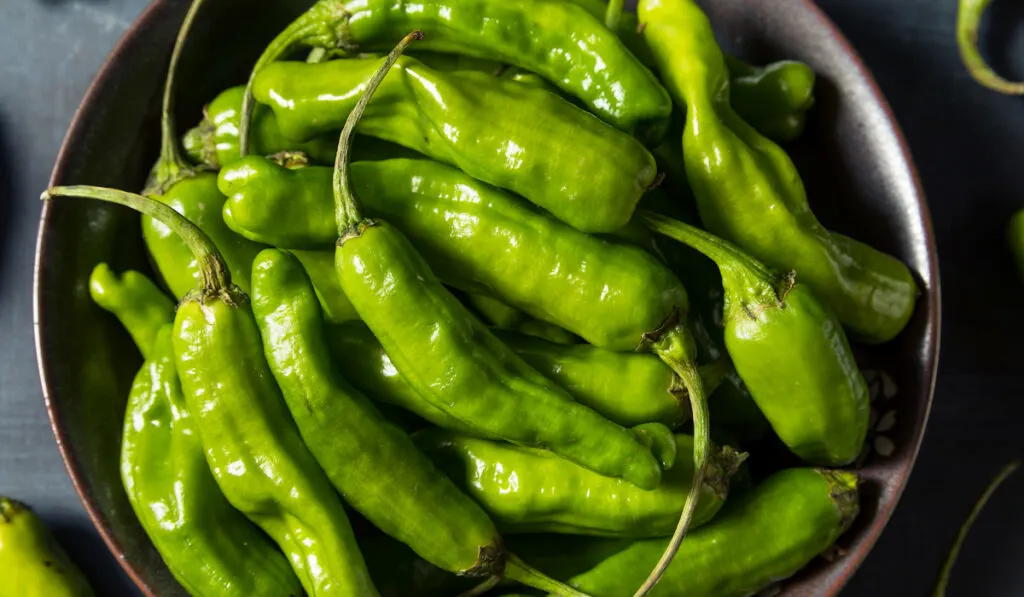
Scoville Heat Units: 50 to 200
The Shihito pepper is an East Asian pepper that is slightly bitter with very little heat. Statistically speaking, only 1 out of 10 Shihito peppers are hot.
These peppers are usually picked while still green and are commonly pan-seared in an oil, charred, grilled, blistered, stuffed, and they can be eaten raw, too. They can also be added to pizza and they make great appetizers.
Once they mature, their green skin turns red.
18. Sport Pepper
Scoville Heat Units: 10,000 to 23,000
Typically found in the Southern US, Sport pepper is a key ingredient in a Chicago-style hot dog. A spicy pepper that brings a kick of heat to any dish, Sport peppers are usually pickled and served with pizzas and sandwiches, including Italian beef sandwiches which Chicago is known for aside from their hot dogs.
Sport peppers are short and green in color, but once they are pickled with vinegar, they turn a pale green. Aside from being spicy, pickled sport peppers are also a little bit tangy and vinegary in flavor.
19. Tiburon Hybrid Chili Pepper
Scoville Heat Units: 1,000 – 2,000
A type of Poblano pepper, the Tiburon Hybrid chili pepper is a large pepper that measures around 5 to 7 inches long, and 2.5 to 3.5 inches wide. These pendant-shaped peppers have medium-thick walls which makes them a great choice for stuffing and roasting.
Like most peppers, the Tiburon Hybrid starts from dark green and then matures to red. Some people dry and smoke them before they are turned into ancho powder.
Nutrients in Pepper
While each type of pepper varies in the amount of nutrients, generally, peppers contain vitamin C, vitamin A, potassium, fiber, and folic acid.
Moreover, capsaicin – a key element in peppers, is known to improve metabolism and suppress appetite which makes them helpful in weight loss.
Resources:
- https://www.epicurious.com/ingredients/20-types-of-peppers-and-their-uses-article
- https://www.jessicagavin.com/types-of-peppers
- https://www.purewow.com/food/types-of-peppers
- https://www.chilipeppermadness.com/chili-pepper-types/medium-hot-chili-peppers/bird-s-eye-chili-peppers
- https://www.chilipeppermadness.com/chili-pepper-types/sweet-mild-chili-peppers/sweet-bell-peppers
- https://www.chilipeppermadness.com/chili-pepper-types/medium-hot-chili-peppers/barkers-hot-chili-peppers
- https://www.chilipeppermadness.com/chili-pepper-types/ancho-ranchero-peppers
- https://www.chilipeppermadness.com/chili-pepper-types/sweet-mild-chili-peppers/cubanelle-chili-peppers
- https://www.chilipeppermadness.com/chili-pepper-types/guindilla-pepper-all-about-them
- https://www.chilipeppermadness.com/chili-pepper-types/sweet-mild-chili-peppers/hatch-chili-peppers
- https://www.chilipeppermadness.com/chili-pepper-types/sweet-mild-chili-peppers/pimiento-de-padron
- https://www.chilipeppermadness.com/chili-pepper-types/medium-heat-chili-peppers/sandia-chili-peppers
- https://www.chilipeppermadness.com/chili-pepper-types/sport-peppers
- https://www.chilipeppermadness.com/chili-pepper-types/sweet-mild-chili-peppers/super-shepherd-chili-pepper
- https://www.chilipeppermadness.com/chili-pepper-types/tiburon-hybrid
- https://www.chilipeppermadness.com/chili-pepper-types/medium-hot-chili-peppers/hidalgo-chili-peppers
- https://www.chilipeppermadness.com/chili-pepper-types/sweet-mild-chili-peppers/hj8-total-eclipse-space-chili-pepper
- https://www.chilipeppermadness.com/chili-pepper-types/superhot-chili-peppers/naga-viper-chili-peppers
- https://www.chilipeppermadness.com/chili-pepper-types
- https://www.chilipeppermadness.com/chili-pepper-types/sweet-mild-chili-peppers/anaheim-chili-peppers
- https://www.masterclass.com/articles/how-to-use-pasilla-peppers#what-are-pasilla-peppers
- https://www.chilipeppermadness.com/chili-pepper-types/sweet-mild-chili-peppers/chilaca-chili-peppers
- https://www.chilipeppermadness.com/chili-pepper-types/sweet-mild-chili-peppers/poblano-chili-peppers
- https://www.chilipeppermadness.com/chili-pepper-types/medium-hot-chili-peppers/serrano-peppers
- https://www.chilipeppermadness.com/chili-pepper-types/shishito-chili-peppers
